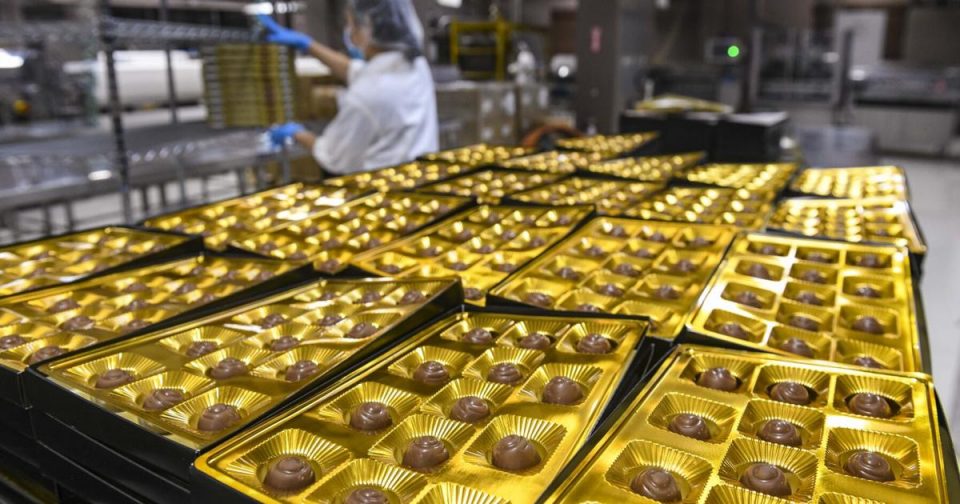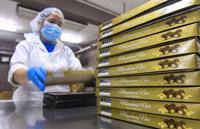Trays of chocolate-covered macadamia nuts wait to be boxed by employees at the Guam Premium Chocolate factory in Barrigada on Sept. 16, 2022.
Guam Premium Chocolate resumed making macadamia-wrapped chocolate goodies after a 28-month pandemic closure, but the factory has fewer workers and lower output for now.
It closed its remaining Chocolate store at Micronesia Mall early this year, after more than two years of significantly low revenue.
Guam Premium Chocolate president and owner George Patterson said the $8 million state-of-the-art chocolate factory in Barrigada resumed operations in mid-August as duty-free shops and retailers such as Kmart and ABC Stores placed orders for “Made in Guam” chocolate products.
The factory completely halted production in April 2020, he said, but the slowdown started months before, when tourist arrivals began declining.
Even with recent orders, demand is still not enough to bring back all 35 employees, Patterson said.
Production resumed with only 10 workers.
Boxes of chocolate-covered macadamia nuts are stacked in preparation for final wrapping by employees at the Guam Premium Chocolate factory in Barrigada on Sept. 16, 2022.
“With the tourist market, our sales have dropped. We’re only doing 10% of what we were doing back then,” Patterson said, while giving the Pacific Daily News a tour of the Barrigada chocolate factory.
Japanese tourism
Prior to the closure, the factory was churning out anywhere from 150,000 to 300,000 chocolate goodies a day.
Foil holders cradling two pieces of chocolate-covered macadamia nuts are loaded onto a conveyor belt for individual wrapping by employees at the Guam Premium Chocolate factory in Barrigada on Sept. 16, 2022.
These days, that’s down to about 20,000 to 30,000 a day.
Patterson said it could take two years to return to pre-pandemic production levels, based on the slow return of tourists, especially Japanese visitors.
“The Japanese have always been coming back with chocolates and confectionery products to take back with them to Japan and given as gifts, saying they were here because we have ‘Made in Guam’ in all of our products,” he said.
Japanese arrivals to Guam have remained at below 3,000 a month, compared with more than 50,000 a month prior to the pandemic.
South Korean travelers are leading the tourism comeback for Guam, with more than 20,000 a month. That’s still significantly lower than pre-pandemic numbers.
Patterson, who also owns Suncare Distributors, said Korean travelers mostly buy vitamin products and other goods.
“As far as chocolate, that’s not what they usually buy to take back as gifts,” he said.
Patterson said the government, particularly the Guam Visitors Bureau, could do more to “go out there” and market Guam to the Japanese and others.
“We can’t do it alone. We need the government’s help,” he said, adding that other pandemic problems were created by shutdowns and lockdowns.
Using federal pandemic relief and recovery funds, the government of Guam provided financial aid to small businesses on top of direct federal aid. But for many, the economic fallout from the pandemic and its restrictions resulted in permanent business closures.
Patterson said while more chocolate factory employees wanted to come back, the business is cautiously weighing several factors. They don’t want to hire back more people, only to furlough them weeks later if arrivals decrease or another variant leads to more government restrictions.
Everything’s gone up
Guam Premier Chocolate, according to Patterson, is the only factory on Guam that makes use of real chocolate, which is pricier than the compound chocolate that others use.
Since the temporary closure, the cost of shipping ingredients such as real chocolate from Belgium and macadamia nuts from Hawaii has gone up.
That means the cost of production is much more than before.
Cookies they used to get from Saipan for $4 a pound have gone up to $8.50 a pound, Patterson said.
“So it’s doubled. Shipping has gone up, everything has gone up,” he said.
George Patterson, Guam Premium Chocolate president and owner, sets a six-pound block of chocolate into a heated vat to be melted and eventually used to create chocolate-covered macadamia nuts at the company’s factory in Barrigada on Sept. 16, 2022.
They had to temporarily discontinue some products while waiting for a higher tourist volume.
Patterson said the company has not raised product prices and has been absorbing added production costs to maintain a share of the market.
“Our profit margin is the one that’s suffering,” he said.
Although the factory wasn’t churning out products during the pandemic, it still had to keep the air conditioners on, and machines had to be maintained to prevent deterioration. Those costs never went away, he said.
Losing money
Guam Premium Chocolate closed its Chocolate store at the Guam Premier Outlets in October 2020. But it kept the store at Micronesia Mall, hoping tourism would come back sooner.
“Every single month, we’re losing money. We‘re just to a point where we had to close it,” he said. When things were starting to look up late last year, the delta variant forced tourists to cancel their flights.
Following the uptick in tourism during the summer, the factory got orders from duty-free shops and retailers. Orders began coming from Saipan.
“We’re getting quite a bit of orders coming back in,” Patterson said. “But nowhere close to what it was before.”






